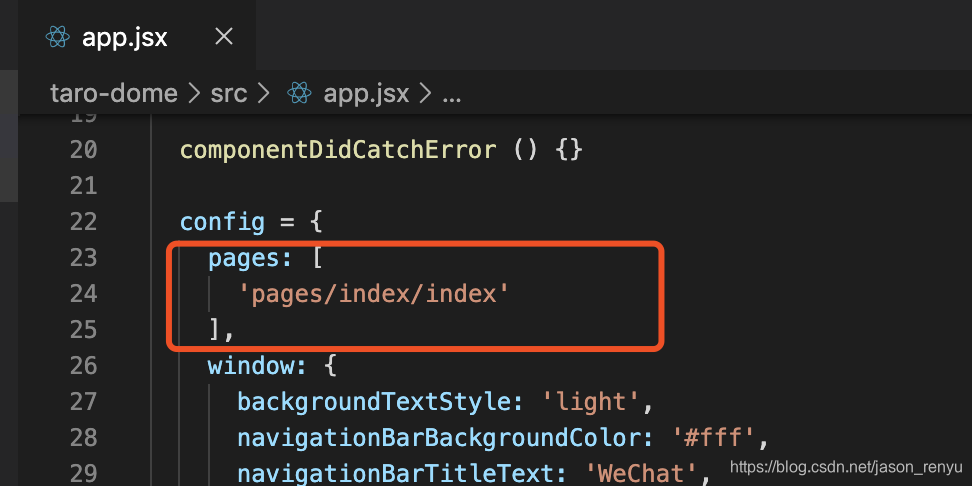从这节开始就要进入Taro的编码部分,Taro的编码是用React的方式,现在的React在普及用React Hooks的方式来书写React,那么在Taro的学习和使用中,我们也将以Hooks的方式来。
Taro使用Hooks的新特性
React Hooks的优缺点
既然我们要用Hooks来写,我们就要了解React Hooks的优缺点,为什么要用Hooks,那么我们就来看下Hooks的优缺点吧!
这个优缺点是通过和传统的React.Component进行对比得出的。
React Hooks的优点
- 更容易复用代码
- 清爽的代码风格
- 代码量更少
- 更容易发现无用的状态和函数
- 更容易拆分组件
React Hooks的缺点
- 状态不同步
- 副作用代码从主动式变成响应式
如何避免React Hooks的常见问题
- 不要在useEffect里面写太多的依赖项,划分这些依赖项成多个useEffect,这样更好维护
- 如果你碰到状态不同步的问题,可以考虑下手动传递参数到函数。如:
// showCount的count来自父级作用域
const [count,setCount] = useState(xxx);
function showCount(){ console.log(count) }
// showCount的count来自参数
const [count,setCount] = useState(xxx);
function showCount(c){ console.log(c) }
- 一定要加入eslint-plugin-react-hooks这个插件,并且重视它的警告
- 使用useRef来保存你的引用并在re-render的时候主动更新ref的对应属性,这样可以避免“引用是旧”的这个烦人的问题,但这种方式hack味道浓郁。
使用Hooks来改写Index组件
在src/pages/index/index.jsx文件:
原文件:
import Taro, { Component } from '@tarojs/taro'
import { View, Text } from '@tarojs/components'
import './index.less'
export default class Index extends Component {
componentWillMount () { }
componentDidMount () { }
componentWillUnmount () { }
componentDidShow () { }
componentDidHide () { }
config = {
navigationBarTitleText: '首页'
}
render () {
return (
<View className='index'>
<Text>Hello world!</Text>
</View>
)
}
}
修改成hooks方式:
import Taro, { useState } from '@tarojs/taro'
import { View, Text } from '@tarojs/components'
import './index.less'
function Index(){
const [userName] = useState('Hello Taro!')
return (
<View>
<Text>{userName}</Text>
</View>
)
}
export default Index
如果你对React Hooks不熟悉的话,这里有一套免费的Hooks学习视频教程:https://www.jspang.com/detailed?id=59
如果您对React也不太熟悉的话,没关系这边有一整套的React学习视频,学习完后上手项目没有问题的:https://jspang.com/detailed?id=56
Taro中组件传值
使用Taro 的一个好处就是要可以用组件化的方式进行编程,所以编写组件在Taro中是每天都需要作的工作。
下边我们先来创建一个自组件,然后进行组件的传值,Taro的组件传值跟React的一样利用props,因此如果你对React的组件传值比较熟悉的化,这里很容易理解。
在Taro项目中的src/pages/index文件夹下面建立一个Child组件
child.jsx组件
import { View, Text } from '@tarojs/components'
function Child(){
return (
<View><Text>我是子组件</Text></View>
)
}
然后在Index组件中引入,这里给出全部代码方便学习
import Taro, { useState } from '@tarojs/taro'
import { View, Text } from '@tarojs/components'
import './index.less'
import Child from "./child"
function Index(){
const [userName] = useState('Hello Taro!')
return (
<View>
<Text>{userName}</Text>
<Child></Child>
</View>
)
}
export default Index
父组件向子组件传值
在上边说过,Taro的传值跟React的一样,父组件向子组件传值是通过props进行;
在Taro中也是可以这样传值的,现在修改index.jsx代码,把userName传递给子组件。
import Taro, { useState } from '@tarojs/taro'
import { View, Text } from '@tarojs/components'
import './index.less'
import Child from "./child"
function Index(){
const [userName] = useState('Hello Taro!')
return (
<View>
<Text>{userName}</Text>
<Child userInfo={userName} ></Child>
</View>
)
}
export default Index
传递后,子组件要增加props参数,然后才能用props进行接收。
import { View, Text } from '@tarojs/components'
function Child(props){
return (
<View>
<Text>我是子组件</Text>
<View><Text>接收来自父组件的值:{props.userInfo}</Text></View>
</View>
)
}
export default Child
这个组件间的传值非常的简单,当我们会用组件的形式编写页面和组件时,你就可以作一些小东西了。
但现在你可以看到,我们把页面和组件放到了一个文件夹下,并且都使用了jsx扩展名。
那Taro时如何区分那些是组件,那些是页面的?
其实它是通过自身的路由来区分的,只要配置路由的,就是页面,没配置的就默认是组件。
下边我们来看下Taro中的路由吧!
Taro 路由配置和介绍
Taro中的路由和React 的路由不同,它是通过app.jsx中的pages来配置的,并且谁配置在第一个数组位置,谁就是默认打开的首页。

首先配置路由
新建一个页面
在/src/pages/文件夹下,建立一个/blog文件夹,在文件夹下面建立一个blog.jsx文件,写入下面的代码:
import {View , Text} from '@tarojs/components'
function Blog(){
return (
<View>
<Text>Blog Page</Text>
</View>
)
}
export default Blog
路由配置
有了页面之后就可以到/src/app.jsx下,然后在pages的数组里面加入代码。
pages: [
'pages/blog/blog',
'pages/index/index'
],
这里需要注意一点,就是你不需要用import引入Blog页面,这个Taro为我们自动做好了。修改完成后,可以到浏览器中看一下,可以看到默认页面已经变成了Blog页面了。
页面间的跳转
页面跳转的方法
Taro提供了6个相关的导航API,我们可以使用这些API进行跳转,需要注意的是这些有些是小程序专用的。
- navigateTo: 最基本的跳转方式,可以返回上级页面。三端都支持的,小程序、H5、React Native。
- redirectTo:不记录上集页面,直接跳转。三端都支持的,小程序、H5、* React Native。
- switchTab: Tab之间进行切换,这个要配合Taro的导航栏一起使用,三端都支持的,小程序、H5、React Native。
- navigateBack: 返回上一级页面,这个在小程序中常使用,三端都支持的,小程序、H5、React Native。
- relaunch:关闭所有额面,打开到应用内某个页面。三端都支持的,小程序、H5、React Native。
- getCurrentPages: 获取当前页面信息所用,这个H5是不支持的。(注意)
页面跳转Demo
做个Demo,我们从Blog页面,跳转到Index页面,我们的程序如何来编写。
为了方便学习这里给出blog.jsx的全部代码:
import Taro from '@tarojs/taro'
import {View , Text ,Button} from '@tarojs/components'
function Blog(){
const gotoIndex=()=>{
Taro.navigateTo({url:'/pages/index/index'})
}
return (
<View>
<Text>Blog Page</Text>
<Button onClick={gotoIndex}>我要去Index页面</Button>
</View>
)
}
export default Blog
这样我们就实现了Taro中路由的跳转。
Taro路由传参
Taro的路由传参利用查询字符串的形式
Taro中进行传参,一般会使用查询字符串的形式,也就是在跳转的url上,加一个?问号的形式,然后后边跟上参数。
现在我们就在Blog.jsx页面用,useState的形式声明一个变量,再通过跳转把值带到Index.jsx页面。
import Taro ,{useState}from '@tarojs/taro'
import {View , Text ,Button} from '@tarojs/components'
function Blog(){
const [blogTitle,setBlogTitle]=useState('JSPang Blog')
const gotoIndex=()=>{
Taro.navigateTo({url:'/pages/index/index?blogTitle='+blogTitle})
}
return (
<View>
<Text>Blog Page</Text>
<Button onClick={gotoIndex}>我要去Index页面</Button>
</View>
)
}
export default Blog
接收传递参数并显示在页面上
在参数已经可以传递了,那如何在Index.jsx进行接收那,其实也非常简单。只要使用this.$router.params就可以进行接收。
当然我们要接收参数,可以在useEffect()中进行(useEffect是React Hooks的方法,不了解的同学请去了解下),
useEffect(()=>{
setBlogTitle(this.$router.params.blogTitle)
},[])
为了更好的学习,这给出接收的全部代码,
index.jsx的代码:
import Taro, { useState ,useEffect} from '@tarojs/taro'
import { View, Text } from '@tarojs/components'
import Child from './child.jsx'
import './index.less'
function Index(props){
const [userName ,setUserName] = useState('Hello World!!!!')
const [blogTitle,setBlogTitle] = useState('')
useEffect(()=>{
setBlogTitle(this.$router.params.blogTitle)
},[])
return (
<View>
<Text>{userName}</Text>
<Child userName={userName}></Child>
<View>{blogTitle}</View>
</View>
)
}
export default Index
多参数的传递和接收
多个参数和多个参数的接收,传递的时候只要用&进行链接就可以了,比如下面这样。(有前端开发经验的同学,对这个肯定不会陌生)
Taro.navigateTo({url:'/pages/index/index?blogTitle='+blogTitle+'&introduce='+introduce})
为了学习方便,这里给出blog,jsx的全部代码:
import Taro ,{useState}from '@tarojs/taro'
import {View , Text ,Button} from '@tarojs/components'
function Blog(){
introduce
const [blogTitle,setBlogTitle]=useState('JSPangBlog')
const [introduce,setIntroduce]=useState('111111')
const gotoIndex=()=>{
Taro.navigateTo({url:'/pages/index/index?blogTitle='+blogTitle+'&introduce='+introduce})
}
return (
<View>
<Text>Blog Page</Text>
<Button onClick={gotoIndex}>我要去Index页面</Button>
</View>
)
}
export default Blog
接收参数跟单参数接收方法一样,不作过多介绍,直接给出代码,
index.jsx代码:
import Taro, { useState ,useEffect} from '@tarojs/taro'
import { View, Text } from '@tarojs/components'
import Child from './child.jsx'
import './index.less'
function Index(props){
const [userName ,setUserName] = useState('Hello World!!!!')
const [blogTitle,setBlogTitle] = useState('')
const [introduce,setIntroduce]=useState('')
useEffect(()=>{
setBlogTitle(this.$router.params.blogTitle)
setIntroduce(this.$router.params.introduce)
},[])
return (
<View>
<Text>{userName}</Text>
<Child userName={userName}></Child>
<View>{blogTitle}</View>
<View>{introduce}</View>
</View>
)
}
export default Index
本篇主要对Taro用React Hooks的方式编写组件以及组件的传参,还有路由和路由参的介绍,如果你对React Hooks不熟悉的要恶补一下React Hooks的知识,如果你对React还有JSX语法也不熟悉,更要多恶补一下了。
